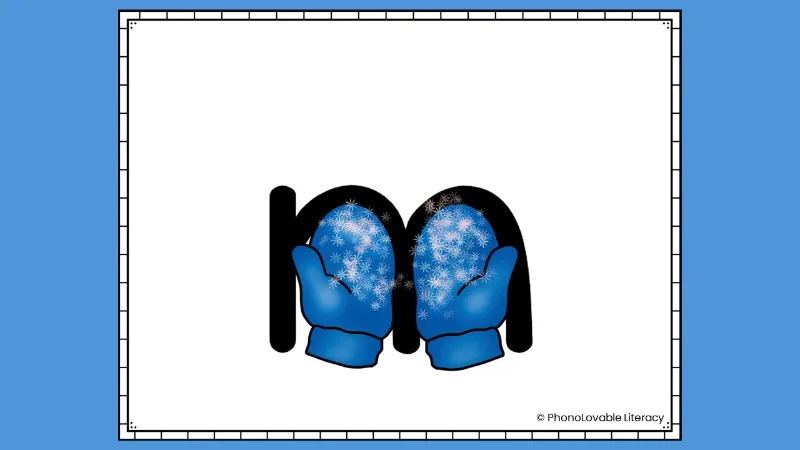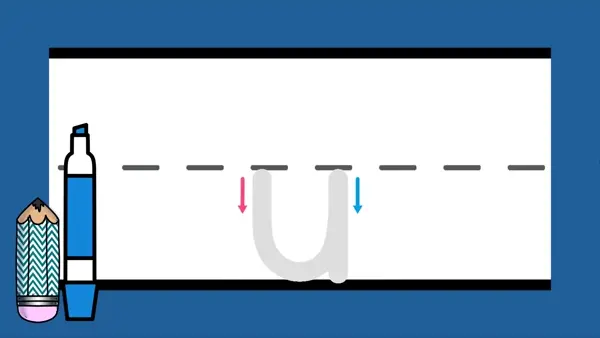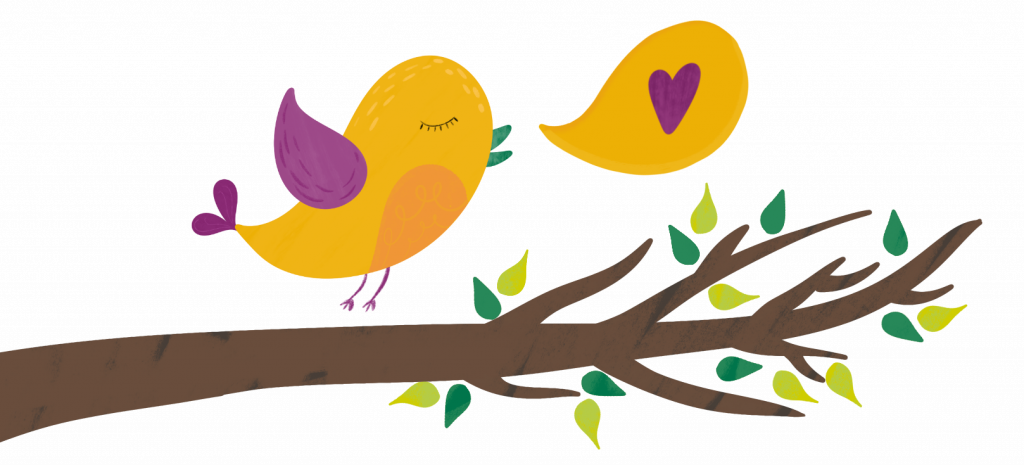Are you getting ready to teach the letter m sound?
Do you want to make sure your practice is aligned with the “Science of Reading” (SoR)?
I used to follow a routine that went something like this:
“Let’s meet the letter m (holding up a card with the printed letter m). M says /m/, as in mittens (showing a picture of mittens). Repeat after me, M, mittens, /m/”.
For the past few years I’ve been implementing a slightly different routine, and the results have been wonderful!
So here’s what I do and why I do it. I’m sharing in hopes that you’ll get something new and easy to try with your own students.
Routine for Introducing the Letter M and Its Sound
You can watch this video to get an idea of the entire routine. Or, just hit play for your students and sit back in your teacher chair with your favorite daytime beverage while we do the teaching for you.
Start with speech.
Why?
Our brains are naturally wired for speaking, not reading. Starting with speech, as opposed to print, gives our students an instant win that feels good. All they have to do is look at photos of interesting things like monkeys, the moon, and macaroni, and repeat each word after their teacher says it. There’s no pressure, and it’s comfortable and familiar. There’s nothing abstract like letter names or printed letters yet.


How?
Say 3-6 words that begin with the letter m, such as monkeys, mouse, mail, macaroni, Moon, and mittens. Ask children to repeat each word after you say it. Show pictures if you have them. This adds interest and can be especially helpful for students with limited English vocabulary and kids who struggle to pay attention to just auditory information. Tell students that all of these words begin with the sound /m/.
Draw attention to what your mouth does when you make the /m/ sound.
Why?
Drawing our children’s attention to how our mouths look and feel while producing the sound makes an abstract concept (such as a letter) more concrete. It simply adds another layer of connection to serve as a bridge between the phoneme and the grapheme. Students can both see and feel the sound being produced.


How?
Ask students to notice what their mouth is doing to make the sound /m/. If you are in a small group, hold up a mirror to let students see for themselves. Draw attention to the fact that our lips need to press together as we make a humming sound. The mouth is closed while the air comes out of the nose. Prove this by asking your kids to hold onto the /m/ sound and then quickly plug their nose between their fingers. Make sure they release their fingers as soon as they realize that the sound disappears!
Introduce the printed letter with an EMBEDDED mnemonic.
Why?
Research has confirmed that using embedded images, keyword pictures displayed within the letter as opposed to apart from the letter (above, below, beside), resulted in student improvement in both the acquisition AND retention of letter-sound correspondences. Using pictures, especially ones of relatable objects, to help kids connect letter-sound relationships makes so much sense. But it was great to read several research studies that prove it.


How?
Now is the time to show your students the printed letter. But not just a plain letter, an embedded letter. The image of a keyword such as mittens embedded in the letter m helps solidify the association between letter and sound. As pictured above, the shape of the mittens corresponding to the shape of the lowercase letter m will serve as a reminder of the phoneme relationship.
I add a little saying for each mnemonic for extra connection. For m, we say “Mary’s mom makes warm mittens.” Feel free to use this or come up with your own alliterative statement with your students.
Model and practice how to write the letter.
Why?
Reading and writing are interconnected. We teach letter sounds so that students may not only read new words, but learn to write them as well. As an interventionist who works with students from kindergarten to 4th grade, I’ve seen how hard it is to undo inefficient letter formation habits. For the past few years, I’ve made it a point to prioritize letter formation as early as possible.


How?
I try to make my letter formation phrasing catchy and singsongy to aid in memory. You may have different wording from a program you’ve used, or you may wish to change up how you say this, but here’s what I say as I model how to write the lowercase letter m:
“Start at the middle. Little line down, push it up, and around and around.”
I model touching the bottom line when I go down and hitting the middle line when I go up. I also show an animated slide on my computer (in small group) or smart TV (in whole group), and students to follow along with their fingers in the air. If children are seated at desks, I ask them to finger-write it on the desk.
I usually have students practice without a writing utensil a few times before I ask them to write with a dry-erase marker or pencil. This is just so I can make sure they’ve got the movements down before they put it on paper.
Research-Aligned Alphabet Resources
Need effective and easy-to-use resources to implement the steps above?
Feel free to preview our “everything bundle” of embedded letter resources, including digital slides, letter cards, worksheets, games, and more! Get your students quickly and effectively mastering letter sounds so they can begin the even more exciting discovery of how to read and write words! Current savings are at nearly 50% off for all 12 resources!


Want a free set of small embedded letter cards? When you join us in our newsletter community, we’ll set you a complementary set as a thankyou gift.
Sources:
Ehri, L. C., Deffner, N. D., & Wilce, L. S. (1984). Pictorial mnemonics for phonics. Journal of Educational Psychology, 76(5), 880–893. https://doi.org/10.1037/0022-0663.76.5.880
Ehri, L. C. (2013). Orthographic Mapping in the Acquisition of Sight Word Reading, Spelling Memory, and Vocabulary Learning. Scientific Studies of Reading, 18(1), 5–21. https://doi.org/10.1080/10888438.2013.819356
Ehri, L.C. (2022). What Teachers Need to Know and Do to Teach Letter–Sounds, Phonemic Awareness, Word Reading, and Phonics. The Reading Teacher, 76(1), 53-61. https://doi.org/10.1002/trtr.2095
McNamara, G. (2012). The effectiveness of embedded picture mnemonic alphabet cards on letter recognition and letter sound knowledge. Theses and Dissertations. 302. https://rdw.rowan.edu/etd/302
Shmidman, A., & Ehri, L. (2010). Embedded Picture Mnemonics to Learn Letters. Scientific Studies of Reading, 14(2), 159–182. https://doi.org/10.1080/10888430903117492

